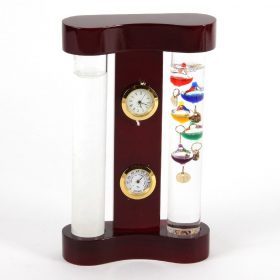We all have several antique objects at our place that decorate our homes in some way or another.
We have photo frames at our homes!!
We have paintings in our homes!!
Night lamps to get off from darkness and in the morning the same works as a decorative objective!!
What else do you have?
Well, Any Antique Scientific Object?
No?
In our lives, we always have thought and talked about the latest technologies!!!
But have you ever gone through the inventions which were done earlier by scientists of 16,17, or the 18th century?
What if I tell you about Galileo Thermometer and Storm Glass?
ENGROSSING, isn’t it?
Let’s go through to those Ancient Times!
Back then in the 17th century when there was nothing to analyze the temperature, Galileo Galilei was the scientist who discovered the principles of the Galileo thermometer. And made it possible to calculate the temperature of the outside environment.
And then after some time in the 17th century itself, there was an invention of Storm Glass which helped the people of those times to forecast the weather of the nearby environment. On top of that, the invention was done by Admiral Fitzroy, the student of Galileo Galilei himself.
Have a look at the functionalities of both the inventions!!
The working and the functionalities of both Galileo Thermometer and Storm Glass will make you ASTOUND for sure!!
Let’s begin with galileo thermometer,
Galileo thermometer is a sealed glass tube with some liquid and 5 floating bubbles on it.
Each floating bubble consists of a tag attached to it in the bottom which represents the temperature.
Every bubble is indifferent in size, colour and temperature.
The moment there is a change in the outside temperature there will be some significant changes in the internal environment of the glass tube.
And therefore, The Bubbles would go up and down accordingly.
| Bubble Colour | Bubble Temperature |
| BLUE | 60 DEGREES |
| YELLOW | 65 DEGREES |
| GREEN | 70 DEGREES |
| PURPLE | 75 DEGREES |
| RED | 80 DEGREES |
In the above-given table, those are the bubble colour and adjacent to it, the temperature is recorded.
Now, the bubble with the lowest degrees has a higher density.
And accordingly, it goes on decreasing in decreasing order.
Therefore, when it comes to red colour bubbles it has the highest degrees but has the lowest density than others.
Suppose the temperature outside is 65 degrees. Then the changes you will see in the glass tube will be :
Ø Lowest density bubbles than 65 degrees will float to the top, i.e. the green, purple and red colour bubbles will float to the top.
Ø The highest density bubble of 65 degrees will float to the bottom (blue colour bubble).
Ø Whereas, the bubble which contains 65 degrees will flat in between the high-density bubbles and the low-density bubbles in this case.
So, this was how the temperature was recorded at those times whose principles were given by Galileo Galilei.
Coming on to next!!
Let me walk you through another invention which was The Storm Glass Uk
As stated above Storm Glass was invented to look and predict the weather of the outside environment.
The storm glass is a sealed glass tube which consists of liquid and ingredients in it.
The liquid is the distilled water along with ethanol and potassium in it as an ingredient.
So, how does it illustrate?
Ø If the glass’s liquid is clear, then the weather outside will be clear.
Ø If the liquid turns out to be cloudy, the weather outside will also be cloudy.
Ø The weather will turn out to be humid and foggy if you see some small dots in the liquid.
Ø You can expect thunderstorms if your glass is cloudy with tiny stars.
Ø In winters, if you see small stars in it, it indicates the snow is expected.
Ø If those ingredients other than liquid remain in the bottom then it’s a frost outside.
Ø And if you see some threads floating on the top, it will be windy outside.
Hence, these were some signs that Storm Glass indicates which helped the scientists of earlier times to forecast the weather.
Those were some sensational research, aren’t it?
Still, Wondering how those things were done at those times?
How about if I say you can get them and experience those times?
Yes, you can get the Galileo Thermometer and Storm Glass for yourself.
People purchase those products from the market separately!
But how about if I say you can get both a galileo thermometer and storm glass in one product?
Satisfying, yes?
Don’t worry about the bill!!
You can get both Galileo Thermometer and Storm Glass at half the price you pay for purchasing both of them separately.
Isn’t it A Happy Deal?
Go Grab one before it gets out of stock!!
Experience analysing the temperature with Galileo Thermometer and forecasting the weather with Storm Glass.



